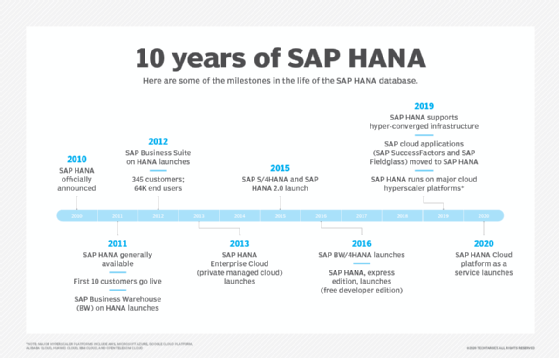
carloscastilla - Fotolia
SAP in 2020: COVID-19, Klein takes command and Qualtrics IPO
From leadership changes to the massive disruptions caused by the COVID-19 pandemic, it was a year like no other for SAP. Here are some of the most important SAP 2020 stories.
SAP faced challenges at the beginning of 2020, but no one predicted the difficulties that were in store.
Like every company, SAP was affected by the COVID-19 pandemic -- for good and ill. The SAP 2020 financial results were mixed at the beginning of the year, but looked less healthy by the end. However, SAP's enormous global customer base and deep wells of financial resources will no doubt enable it to ride out the economic disaster, experts said. SAP also shined a light on how its technology enabled some organizations to deal with the disruptions brought on by the pandemic.
Despite the continued push to get customers to the cloud, SAP technology remained in a period of transition, with customers holding onto legacy SAP ERP systems rather than embracing the cloud-centric "intelligent enterprise" -- SAP's take on digital transformation where organizations improve existing processes and create new business models.
And then there's the matter of the SAP leadership shuffle. When longtime CEO Bill McDermott resigned in October 2019, SAP put together the leadership duo of co-CEOs Christian Klein and Jennifer Morgan. The partnership was not destined for a long life, however, as Morgan stepped down in April, leaving Klein -- the youngest CEO in SAP history -- at the company's helm.
Here are some of the biggest SAP 2020 themes and stories.
SAP leadership changes and business challenges
SAP began 2020 on decent business footing, according to its Q1 revenue reports. However, warning signs soon emerged, suggesting there was trouble ahead. One red flag was the slow adoption of SAP S/4HANA, the flagship modern ERP.
Another was the economic danger ahead due to the quickly unfolding pandemic crisis.
In April, SAP experienced another jolt, as Morgan, the first woman to lead a company on Germany's DAX, left and Klein assumed the role of CEO. The quick change in leadership was never explained fully, but the company pointed to the pandemic as the underlying reason for its rationale. In a press release, SAP stated, "the decision to transfer from co-CEO to sole CEO model was taken earlier than planned to ensure strong, unambiguous steering in times of an unprecedented crisis."
Later in the year, what started out as warning signs became reality. SAP's revenues fell significantly in Q3, which spooked investors, and the company's stock value declined by 20%. Much of this was attributed to weaknesses in cloud revenue, but analysts believe that SAP's size and deep resources bode well for the company's long-term health.
Questions about SAP's $8 billion acquisition of Qualtrics continued in 2020 and then intensified in July when SAP announced its intentions to spin off the experience management subsidiary in an initial public offering (IPO). The IPO was filed Monday, and Qualtrics' future in the SAP product portfolio remains an open question.

SAP core technology and intelligent enterprise
For its core technology platforms and applications, SAP 2020 was a year for looking back and looking ahead. The year marked the 10th anniversary of the SAP HANA database, the landmark in-memory database that has served as the platform for SAP's ongoing technology evolution.
SAP HANA's ability to combine transactional with analytical data processing has formed the foundation of the SAP intelligent enterprise. At the annual SAP Sapphire Now conference, which was virtual this year, Klein presented SAP's vision of the intelligent enterprise as a data-driven business transformation to modernize existing processes and business models. This is characterized by adopting cloud-based systems that incorporate modern technologies like AI, machine learning and IoT.
Klein argued that the intelligent enterprise can help businesses survive the pandemic as well as future disruptions by making them more resilient, sustainable and even profitable.
SAP also strengthened its capabilities for application development with the SAP Business Technology Platform, a single access point for development products such as SAP HANA database, SAP Data Warehouse Cloud and SAP Analytics Cloud, and SAP Cloud Platform Integration Suite.
SAP S/4HANA momentum -- or lack thereof
SAP's next-generation ERP system S/4HANA is often talked about as the key to the company's future, and SAP has expended considerable effort and resources to move its extensive legacy ERP customer base onto S/4HANA. However, in February, SAP extended mainstream maintenance support for legacy SAP Business Suite 7 applications until 2027, an acknowledgment that S/4HANA migrations were not moving quickly enough.
While customers talk about being on board with an S/4HANA migration, they still appear reluctant to undergo the costly and complex project. The COVID-19 pandemic affected plans for S/4HANA migrations.
Some companies found it difficult to justify the expense of an S/4HANA migration during such uncertain economic times, while others accelerated projects, deciding that the modern ERP would provide flexibility and resiliency to weather the crisis. Some S/4HANA projects were completed despite the challenges brought on by the pandemic and work-from-home orders.
SAP technology tackles COVID-19 challenges
The disruptions caused by COVID-19 produced problems that private companies, governments and other institutions had never faced before.
SAP customers met those challenges by quickly developing applications built on SAP technology. Early in the pandemic, for example, the German Federal Foreign Office engaged with SAP to build a mobile app on the SAP Cloud Platform to help German citizens stranded abroad return home.
The SAP Cloud Platform was also instrumental for developing apps that helped families in the U.S. that rely on the country's lunch program find operating locations and hospitals in Germany manage hospital bed occupancy and availability. The Parkland Health & Hospital System in Dallas was also able to prepare for and manage the huge surge in admissions during the pandemic through a data analytics application built on SAP Digital Boardroom and SAP Analytics Cloud.





